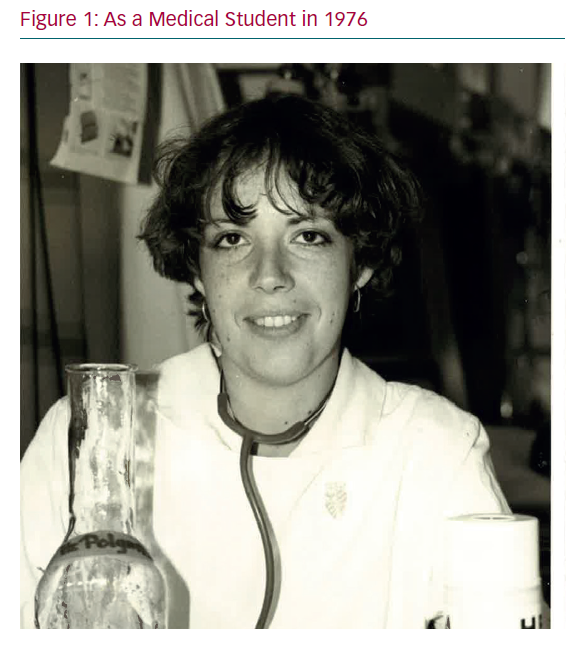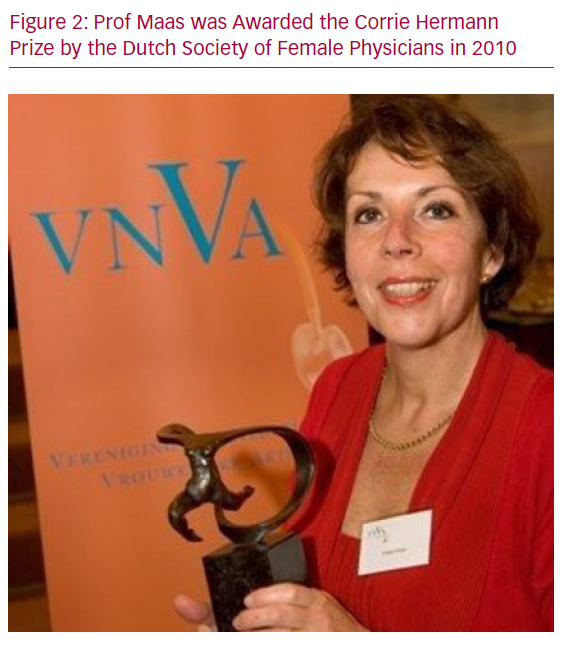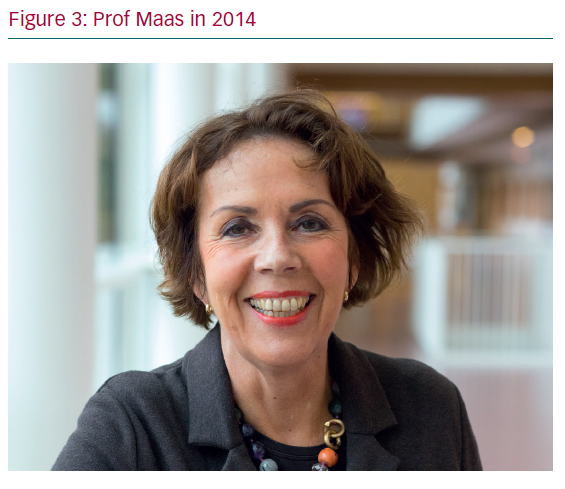When I was a young girl, my father was a family care physician with a home office in our basement. His patients came to our house and I was mesmerised by the whole idea. I’d try to sneak a look in the window of his office, or take him a cup of tea, because I simply had to know what was going on down there. Who were these strange people who came to our house to be treated by my father? What did they look like? I figured they must be a very special kind of species.
So I was a little surprised, and maybe a little disappointed, when I began to realise that they looked just like any other person.
Now, as I look back at my career, I realise that many of my peers in cardiology may have had a similar experience when patients presented with symptoms that contradicted everything they knew to be true about heart disease. Who were these strange creatures with issues that weren’t covered in any of the books?
I, too, had been practising cardiology for a few years before I finally began to understand again that there was nothing strange about them. True, we hadn’t learned about their symptoms in medical school, but they looked like normal people – and they were normal people.
The only difference was that they were women.
Shared Experience
Some years after I had peered into my basement window to see what my father was doing, I, too, decided to become a physician. This delighted him, naturally. I was the second of five children in my family, and the only one to go into medicine. He was proud of all of us, of course, but my career choice created a special empathy.
He encouraged me from the start, and he was there for me again when I most needed encouragement, years later, when I found myself fighting some unexpected uphill battles. He had his own battles along the way, having experienced the sting of derision from his peers, because he was interested in homeopathy. Homeopathy, many general care physicians insisted, was nonsense. Whether it is or isn’t, I don’t really know. It is not my area of interest or expertise. But his experience helped us bond later, when I, too, was derided for wanting to change the way medicine was practised.
Not that I’d started out wanting to change anything. Early on, I just wanted to be a part of the medical world and to fit in.
Early Training
I always loved school, my grades were good, and I chose the subjects I knew I needed to get into medical school. I was helped by what seemed to be almost boundless energy. My friends used to shake their heads in amazement, because I seemed to never wear down. I was always on the front lines, ready to embrace the next intrigue. Your level of energy is something different, they would say.
I was just as enthusiastic in med school. On holidays, I always worked as a nurse. I wanted to be hands-on and to learn as much as I could. Plus, I knew I had to decide what direction I wanted to go in, and I was eager to figure it out. It wasn’t until my last year of medical school that I finally chose cardiology. Why? I think because cardiology is about making decisions fast, and that suited my character. With internal medicine, doctors may think for weeks about something. That’s not my style.
Like many young doctors from the Netherlands, I did my residency on the Caribbean island of Curaçao. The University of Groningen, where I did my training, had an informal agreement with Curaçao for medical students, and I was eager to spend a few years overseas. I was lucky to have the opportunity. The experience was as eye-opening as it was educational. The patients were poor, and I saw first-hand that many parts of the world did not have the same high-standard healthcare system that we enjoy in the Netherlands and other developed nations.
Lukewarm Welcome
An even bigger eye-opener awaited me. When I returned home in 1988 and began practising, I quickly realised that the cardiology community was not very welcoming to women. It was a bit of a jolt. As a student, I had been very involved with the second-wave feminist movement. I had actively participated in seminars and discussion groups that focused on the need for women to find their own directions, to earn their own money, and to make their own decisions.
Cardiology was very male-oriented. It was a men’s community that focused on men’s diseases. This also led to some confusion. I had female patients I wanted to understand and help, but they didn’t seem to fit in with the male-oriented models I’d studied. This was an era of growing enlightenment for women, and my increasingly confident female patients were very upfront about what they were experiencing. They had many questions, but I had very few answers for them.
Initially, I succumbed to the attitudes around me. I should emphasise here that I don’t think male cardiologists are bad people, by any means. Virtually every male cardiologist I know is kind. But the dominant group culture isn’t as kind. And I cringe a little now when I remember that I laughed at some of my female patients because they had ‘stupid’ symptoms. These weren’t the symptoms we’d studied in all the books. These women didn’t have obstructions. The symptoms they described didn’t add up, so we dismissed them. That was normal at the time.
Unnerving Exchange
It was 1991, 3 years into my career, when a confluence of events helped me realise that neither the person I’d become, nor the physician I’d become, were who I wanted to be.
It was around that time that the first literature on sex differences in cardiology disease began to appear, including the seminal book, The Female Heart, by Marianne Legato and Carol Colman. Against this backdrop, I also found myself unnerved one day by an exchange that took place on an otherwise normal day in my office. A middle-aged woman – frustrated to breaking point by the repeated dismissiveness of physicians who refused to take her seriously – finally shouted at me in tears: “Why don’t you explain my complaints?”
Before long, I was reading everything I could about female hearts and the cardiological differences between men and women. And it all began to come together. There were enormous gaps in my knowledge, and I had to fill them. But it seemed as if no one in my country could help me. No one seemed interested.
Eventually, I found myself at odds with virtually the entire Dutch cardiology community. To many, female cardiology was still a non-issue. After all, the whole community had been focused on obstructive cardiology disease for more than 40 years, and women have far less obstructive cardiology disease than men. I had to pry myself away from the dominant attitudes of the time and seek what I now knew to be a broader truth.
Welcome Support
Fortunately, my husband, Ernst, a cardiologist who I met when we happened to sit next to each other at a cardiology dinner in 1985, was there for me as this next chapter of my life unfolded. He knew what I was up against, and he’d ask me, what do you want to change, and how important is this to you? He became both a sounding board and an extremely supportive partner. Among other things, he often took over the care of our two sons, so I could travel abroad and pursue what had become to me a vital path. He’s retired now and still very supportive. Among other things, he takes care of all the food preparation in our home, so I can maintain my demanding schedule.
I submerged myself in the new and growing research community on women’s heart disease, and I earned a PhD while taking part in a worldwide study of female cardiology. In my practice, I began to focus more and more on female patients, and eventually, in 2003, I stopped seeing male patients altogether.
I explained to my befuddled colleagues that it was something I needed to do. Women’s heart issues were clearly different, and I wanted to know why some were more at risk than others.
Of course, many answers had already begun to emerge. Women have less muscle mass than men. Their arteries are smaller. As people age, men usually have more obstructive kinds of coronary disease and aortic stenosis – issues that can be treated relatively easily with a stent or a bypass. But women are much more likely to have non-obstructive coronary diseases – issues that are more difficult, if not impossible, to treat with coronary interventions.
As the heart ages, women experience more stiffness of the myocardium, which often leads to symptoms such as shortness of breath and a different kind of heart failure than the reduced ejection fraction and pattern of heart failure we are used to seeing in men.
All of these are very typical for women between 40 and 70 years. The bottom line is that women and men have distinctly different occurrences of heart disease throughout their lives, and we, as cardiologists, must finally come to understand those differences. Those who can’t, or won’t, accept that these serious sex and gender differences exist, will end up misdiagnosing and mistreating their female patients, or failing to treat them at all.
The Right Direction
Fortunately, we have made enormous progress. But we still have a long way to go. For one, we need to address a large disparity in numbers of practitioners. In Holland, women now account for about 25–30% of all cardiologists. But women are less than 10% of all cardiology professors. Women also hold a vastly disproportionately low percentage of leadership positions at the large teaching hospitals. And not a single woman in Dutch cardiology is the leader of an entire department. Not one.
Since my awakening, I have been striving to provide not just better care for female patients, but also to facilitate better positions for female cardiologists. But the challenge can be nuanced. Ironically, some women who go into cardiology do so because they’re attracted by the macho culture. So, we cannot assume that all female cardiologists will have a special interest in female patients.
In fact, as a professor, I hear concerns and some hesitancy about the culture from both female and male students. The concerns are valid. It’s usually easier when you’re a young physician just starting out to keep your mouth shut than it is to speak up. We need to see the culture for what it is and keep challenging ourselves to move forward.
I’m heartened that Prof Barbara Casadei is now President of the European Society of Cardiology. She is a great example of how things are improving. She’s extremely brave, and she now has the power to help effect change. Most of all, she’s a great example for younger female cardiologists.
Moving Forward
In the meantime, I’m focusing on research and teaching, as well as focusing on women in my own outpatient facility. I’ve recently published my third book, Hearts for Women, and I have four important research subjects that I’m working on with PhD students at the Radboud University Medical Center in Nijmegen, where I am a professor of women’s cardiac health.
First, we are working with gynaecologists, looking at high-risk women who have experienced pre-eclampsia. Second, we are working with women who have specific types of coronary symptoms, such as coronary artery dissections. Those have become increasingly prevalent in younger women who’ve given birth and/or who are dealing with the stresses of our current society. Third, we are looking at middle-aged women with microvascular angina. And last, we are researching cardio-oncology in breast cancer patients.
The fourth area is an interesting example of unintended consequences, and I have a chapter on cardiac damage related to breast cancer in my new book. Physicians are treating breast cancer very well, and mortality has declined enormously over the past decades. But we’re also paying a price. We are seeing more and more cardiovascular damage as a result, sometimes as long as 10–20 years after treatment. It is not yet widely recognised, so when patients complain of fatigue, their physicians may brush it off, attributing it to their breast cancer many years earlier, instead of taking a closer look. As a result, heart failure often remains underdiagnosed years after women are treated for breast cancer.
We know that angiogenesis inhibitors cause hypertension, and that when you do not treat high blood pressure for many years, you are bound to have heart problems. To combat this, we need to take a closer look at individual patients, we need to do more genotyping of tumours, and we need to try to tailor treatments accordingly. New chemotherapy agents and additional therapies can also help. I hope and believe that our perspective will change in the coming years.
When we empower women in healthcare, we elevate the importance of these topics related to women’s health because women are likely to be more interested in them. With more women in leadership positions, these will be higher on the agenda.
My own experience is instructive. I’ve been asked to join various scientific committees, and am also now a senior reviewer of the Lancet Commission on Women and Health. I’m currently involved in the creation of a position paper about global cardiovascular health in women, and I was elected last year to be a Dutch delegate to the UN, starting in 2020. In October 2020, I’ll be giving a short lecture at the UN in New York, about the need to empower women working in healthcare. Currently, 70% of healthcare workers worldwide are women, but only 25% of leadership positions are filled by women.
Persistence Pays
It has not always been easy, by any means, but I have persisted. You have to be strong to honestly assess and, if necessary, change, your behaviour, especially when doing so puts you in conflict with your environment.
I am proud that I have helped to improve care for female patients, and I hope I have helped to change the culture a bit. But change always happens more slowly than you want, and it is always made by many people, not just by one person. Still, in the last 5 years we’ve made more progress than was made in the preceding 20 years. I’m pleased to have been a part of it.
There are also plenty of female cardiology pioneers elsewhere in Europe and in the US, who have been brave enough to go against the mainstream and to fight to change the ways women are diagnosed and treated.
We have a shared experience and it is important for female cardiologists to support each other: to be heart sisters, to discuss our experiences and those of our colleagues; and, above all, to make sure we understand and practise the right science. This is our message: women are still undervalued and undertreated in cardiology. To bring about change, we have to be one force, we have to create understanding; and ultimately, we have to make a difference.














